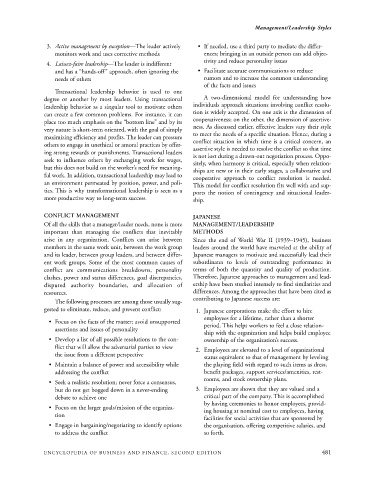Page 504 - Encyclopedia of Business and Finance
P. 504
eobf_M 7/5/06 3:15 PM Page 481
Management/Leadership Styles
3. Active management by exception—The leader actively • If needed, use a third party to mediate the differ-
monitors work and uses corrective methods ences; bringing in an outside person can add objec-
tivity and reduce personality issues
4. Laissez-faire leadership—The leader is indifferent
and has a “hands-off” approach, often ignoring the • Facilitate accurate communications to reduce
needs of others rumors and to increase the common understanding
of the facts and issues
Transactional leadership behavior is used to one
degree or another by most leaders. Using transactional A two-dimensional model for understanding how
leadership behavior as a singular tool to motivate others individuals approach situations involving conflict resolu-
tion is widely accepted. On one axis is the dimension of
can create a few common problems. For instance, it can
cooperativeness; on the other, the dimension of assertive-
place too much emphasis on the “bottom line” and by its
ness. As discussed earlier, effective leaders vary their style
very nature is short-term oriented, with the goal of simply
to meet the needs of a specific situation. Hence, during a
maximizing efficiency and profits. The leader can pressure
conflict situation in which time is a critical concern, an
others to engage in unethical or amoral practices by offer-
assertive style is needed to resolve the conflict so that time
ing strong rewards or punishments. Transactional leaders
is not lost during a drawn-out negotiation process. Oppo-
seek to influence others by exchanging work for wages, sitely, when harmony is critical, especially when relation-
but this does not build on the worker’s need for meaning- ships are new or in their early stages, a collaborative and
ful work. In addition, transactional leadership may lead to
cooperative approach to conflict resolution is needed.
an environment permeated by position, power, and poli- This model for conflict resolution fits well with and sup-
tics. This is why transformational leadership is seen as a ports the notion of contingency and situational leader-
more productive way to long-term success. ship.
CONFLICT MANAGEMENT JAPANESE
Of all the skills that a manager/leader needs, none is more MANAGEMENT/LEADERSHIP
important than managing the conflicts that inevitably METHODS
arise in any organization. Conflicts can arise between Since the end of World War II (1939–1945), business
members in the same work unit, between the work group leaders around the world have marveled at the ability of
and its leader, between group leaders, and between differ- Japanese managers to motivate and successfully lead their
ent work groups. Some of the most common causes of subordinates to levels of outstanding performance in
conflict are communications breakdowns, personality terms of both the quantity and quality of production.
clashes, power and status differences, goal discrepancies, Therefore, Japanese approaches to management and lead-
disputed authority boundaries, and allocation of ership have been studied intensely to find similarities and
resources. differences. Among the approaches that have been cited as
contributing to Japanese success are:
The following processes are among those usually sug-
gested to eliminate, reduce, and prevent conflict: 1. Japanese corporations make the effort to hire
employees for a lifetime, rather than a shorter
• Focus on the facts of the matter; avoid unsupported
period. This helps workers to feel a close relation-
assertions and issues of personality
ship with the organization and helps build employee
• Develop a list of all possible resolutions to the con- ownership of the organization’s success.
flict that will allow the adversarial parties to view
2. Employees are elevated to a level of organizational
the issue from a different perspective
status equivalent to that of management by leveling
• Maintain a balance of power and accessibility while the playing field with regard to such items as dress,
addressing the conflict benefit packages, support services/amenities, rest-
rooms, and stock ownership plans.
• Seek a realistic resolution; never force a consensus,
but do not get bogged down in a never-ending 3. Employees are shown that they are valued and a
debate to achieve one critical part of the company. This is accomplished
by having ceremonies to honor employees, provid-
• Focus on the larger goals/mission of the organiza-
ing housing at nominal cost to employees, having
tion
facilities for social activities that are sponsored by
• Engage in bargaining/negotiating to identify options the organization, offering competitive salaries, and
to address the conflict so forth.
ENCYCLOPEDIA OF BUSINESS AND FINANCE, SECOND EDITION 481

